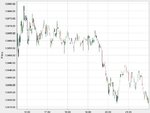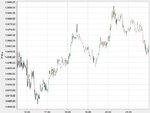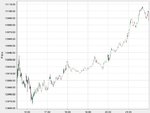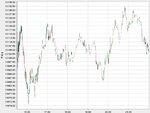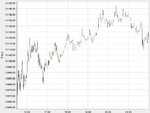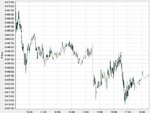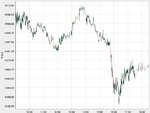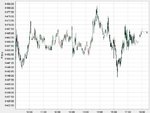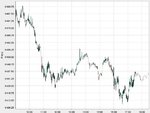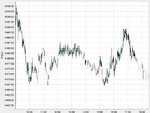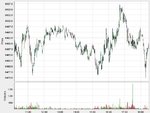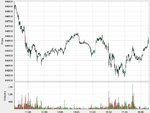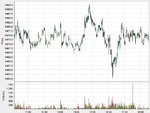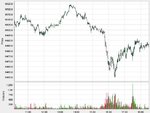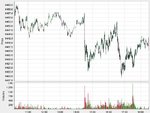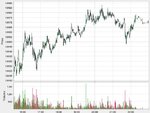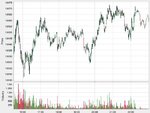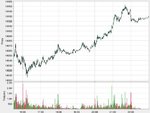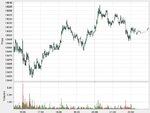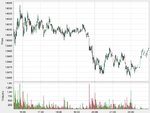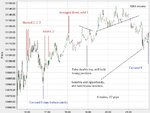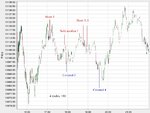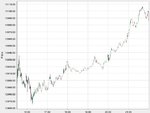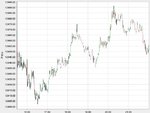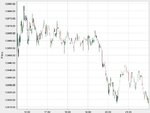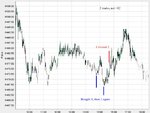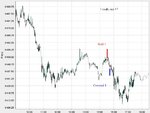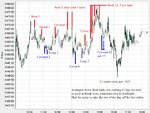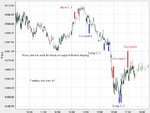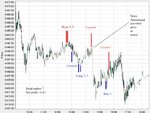Trading Plan, Part One
Why Trade?
I have been interested in the financial markets for as long as I can remember. Trading represents a worthwhile personal challenge, an opportunity to study and learn more about the markets while participating in them. I also have a personal curiosity regarding what I could achieve as a trader, both financially, and in terms of a track record. I am still considering the far out option of managing Other Peoples Money some day...
What sort of trader am I?
Certainly an aggressive intra-day trader. I wish to devote around 10 hours per day to trading, not including preparation and review. I wish to trade for a living some day. I do not feel comfortably holding overnights in volatile markets and have no interest in slow markets. My current risk capital does not permit me to hold overnights. Day trading gives me the opportunity to reach to what the market tells me as it happens, as opposed to spending a few hours a week considering positions.
Strengths and Weaknesses
This will be a difficult one.
Strengths...given my poor track record and lack of a plan I am going to come back to this later to give a proper answer, rather than just fill in some meaningless words here.
Weaknesses. Poor discipline – inability to stick to a plan while in a trade, or formulate a plan before trading. Letting losses run or failing to define a loss. Panicking exits and taking profits too soon. Overtrading, perhaps through boredom, or due to revenge trading. Emtional trading. I'm generally a “high achiver” quite accustomed to success and with an expectation of being correct most of the time. Perhaps some ego issues here.
Discipline to be improved by adherence to a sensible plan I intend to formulate. Emotional issues to be removed by the use of paper trading until confidence in a strategy can be achived.
Are you in the right frame of mind to trade?
During live trading and paper trading, I have traded when;
- overtired
- stressed
- distracted by issues in my life
- busy
- suffering from an inability to concentrate
- after 2 nights without sleep
- on the telephone
- suffering from a bad flu
I've never traded with a hangover! I have never consumed alcohol while trading.
From the outset, I have failed to take advantages of the freedoms of full time trading. One of these is not having to work every day. Due to habit, I have gone to my “new job” while not in a suitable condition to perform effectively.
This plan will include a checklist of personal conditions which must be met prior to trading. Discipline will be important here, as I am fearful of missing opportunities and this gives me a compulsion to trade.
At this juncture, I feel the example answer cannot be improved upon and I therefore incorporate it below:
I will only trade on days when . . . (I am rested, relaxed and not distracted by work or family
etc. I will be guided by my trading plan and I will adhere to it rigidly. It will help to prevent me from
making trades that are poorly conceived and executed; i.e. trades that are based on gut feeing and
motivated by fear and/or greed).
I will not trade on days when . . . (I am feeling off colour, hung over, particularly tired or when
I am mentally distracted by other events in my life).
Financial Targets
I'll work this one out when I can reasonably predict something based on the strategy I adopt. Tempted to pencil in “1% per day” here.
Annual Trading Goal
My annual trading goal is to have a track record of executing a strategy in a disciplined and efficient manner. I wish to have achieved an edge trading index futures. I need not have recovered my losses at this time, or broken even, although this would be highly desirable. I wish to be able to review my P/L, trade frequency, and other relevant statistics and consider that significant progress has been made. I would wish to be able to realistically consider trading for a living at this stage. For the longer term view, I would hope to be comfortable enough to attempt to hold overnight positions on my chosen instruments, and to trade on a longer timescale.
Okay, reward is mentioned in the document, so just for fun (although I have no expectation of making such profit, and even if I do not, if I achieve the goal that will be its own reward).
I would dearly like to visit the Cayman Islands. My reward for achieving these goals will be a one week stay in George Town, Grand Cayman, to include snorkelling and copious amounts of rum punch. Should my profits not permit this, I'll spend a week in Jersey instead (similar enough island, and I had a jolly good time there a few years ago). I don't travel nearly as often as I should.
Monthly Trading Goal
To have returned results consistent with my plan. Achieving a good work / life balance and not let the markets interfere with my personal time. achieve a win loss ratio of 3:1.
Weekly Trading Goals
Discipline, discipline, discipline. To plan the trade, trade the plan, and execute efficiently without hesitation or stress. When I achieve this goal I will reward myself by not worrying about causing myself stress related illnesses while trading!
Daily Trading Goals
Much as I appreciate the value of goal setting, can we get to the bit where we actually make the plan? Will come back later
Markets!
Trade the YM on an intra-day basis. Research the merits of Dax trading in the AM. Both markets provide sufficient volatility and do not appear overly tricky to trade. Timeframes – a 5 minute chart for entries and exits, and a 15 minute chart for general trend / bigger picture. 1 minute charts.
Currently spreadbetting, looking to move to Direct Access on the futures with IB. Long term plan – TwoWayFutures / FuturesBetting (tax reasons, comparable costs)
Trading platform – brokers software, with an eye on an OpenTick feed
Pre market
Check for release of numbers. Check trend of overnight index futures. Review yesterdays performance. Consider how to trade in the current day.
Hour by Hour Plan
TBC
Attitude to Risk
Accepting of the risk associated with intra day trading. Not risk adverse when trading properly. Extremly risk adverse after painful losses, so strict use of stops and discipline breaks after losses required.
Looking to risk a maximum of 2% per trade, one trade at a time.
Hardware / Broker Risk
I have a paper copy of emergency numbers to call to close spreadbets. It will take all day for them to answer the phone, and I will probably be stopped anyways. Hard stops in the market will mitigate this. Multiple computers with relevant software. 1 ADSL line, no backup connection. Maybe consider backup dialup....
Strategy Risk
Will stop after 10% drawdown (or 5 losing trades), and review this “strategy” which I still don't have.
Risk Management
Look for 2:1 reward:risk trades and above.
The remainder TBC.
Stops
Maximum of 2% risk per trade. Move stop to breakeven when prudent to do so.
When to Stop Trading
- First loss after hitting profit target.
- After three losing trades.
- When the market is extremely choppy, or does not produce appropriate setups.
£1pp initially. 1 contract when moving to the futures. No adding to this at this time – will review in the event of my trading capital increasing to the extent I could carry multiple positions with a sensible stop while risking 2% or less.
Exits
Need to read firewalker's excellent thread on the matter, and perhaps Elder Alexander's “Entries and Exits” again. Trailing stop below relevant highs / lows, breakeven stop where appropriate, or exit near a profit target will do meanwhile
More to follow....
Italics represents an unfinished area, will fill more in later
Hope this aids anyone who is reading this, and anyone who wishes to give some advice.

